
Point Lobos State Natural Reserve plants. Photo credit: Paul Reps.
Point Lobos’ vegetation is varied and unique. As you walk or drive through, see if you can identify some of the key land habitats and plant communities including Monterey Cypress in the A.M. Allan Memorial Grove on the Cypress Grove Trail, Monterey Pine Forest along the Pine Ridge, Lace Lichen and North Shore Trail, Northern Coastal Scrub along the Cypress Grove Trail as it heads toward A.M. Allan Memorial Grove, Coastal Bluff along the South Shore Trail and Coastal Prairie and Grasslands at Mound Meadow and on the Moss Cove Trail toward Ixchenta Point. Very important habitats and plant communities can also be found along the shoreline in the intertidal area as well as in deeper water.
Each of these groups of plants is a relatively distinct collection of plant species. Each community exists where it does as a result of complex interactions among a number of factors. These, in turn, affect the ability of these communities to provide food and shelter – habitat – for the animals and birds that depend on them.
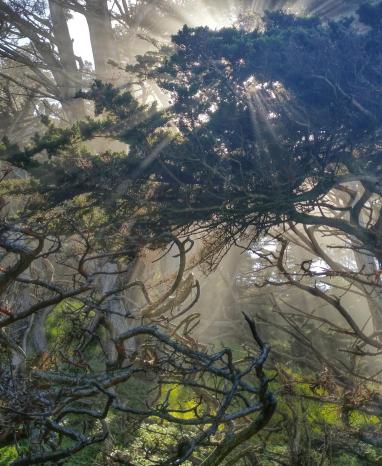
Point Lobos State Natural Reserve forest beauty. Photo credit: Janet Beaty.
Some of those factors include climate, topography, geology, soils, fire, air and water quality, time, and all the organisms big and small that live in the communities. Disturbance and damage from people can also be highly destructive of these habitats, whether through walking off the trail, harassing animals resting on beaches, or other activities.
Plant communities are often named for the dominant species of the community. A species may be dominant either by its physical size, such as the Monterey Cypress forest, or by its numerical dominance. Not all communities have one species which is dominant; these are named for physical or generic characteristics, such as grasslands or scrub, or by habitat, such as coastal bluff communities.
A classic plant community structure can be best seen here in the Monterey Pine forest: a tree species dominating the community by its sheer size, quantity of nutrients its roots absorb and by the needle or leaf litter dropped; a shrub layer of Ceanothus, Coffeeberry and Poison Oak, and an understory of low-growing plants such as the Wood-mint and Douglas Iris.
Not all plant communities follow this structure. The Northern Coastal Scrub community consists mainly of shrub species growing tightly together with a weakly developed understory. Grassland communities generally consist only of grasses and very low-growing herbaceous plants. A careful look at the soils, fog patterns, exposure to salt spray or slope characteristics can give a clue to the differences in the growing conditions in each location.
For example, the coastal bluff community at Bird Island Trail is considered a sub-community of northern coastal scrub. The plants here must be adapted to extreme conditions: intense sun or dense fog, very shallow soils or bare rock, vertical rock faces, direct salt spray and wind. The plant adaptations to this environment are a further refinement of the northern coastal scrub species’ adaptations. Indeed, many of the species are the same, although the size of the individual plants may be greatly reduced.
California Native Plant Society Point Lobos State Natural Reserve Species List
Trees

Three species of trees occur naturally at Point Lobos, the Monterey Pine, the Coast Live Oak, and the Monterey Cypress.
Monterey Pine
Pinus radiata, Monterey pine, is perhaps the most widely planted of all pines, both for lumber and for landscaping, but it occurs naturally in only three places: Año Nuevo Point at the border of San Mateo and Monterey counties; Monterey peninsula from Monterey south to Mal Paso Creek (Carmel Highlands); and Cambria near San Simeon. A variant lives on two islands off Baja California, Mexico.
Monterey pine grows to 80-110 feet; it is symmetrical when young, with an irregular rounded crown at maturity (60-80 years). Its shape can also be distorted if it is crowded by other pines. In favorable conditions, i.e. near the coast, it can live to 100 years but has a much shorter life (less than 50 years) if planted inland. Needles grow in a bundle of three, 3-6 inches long.
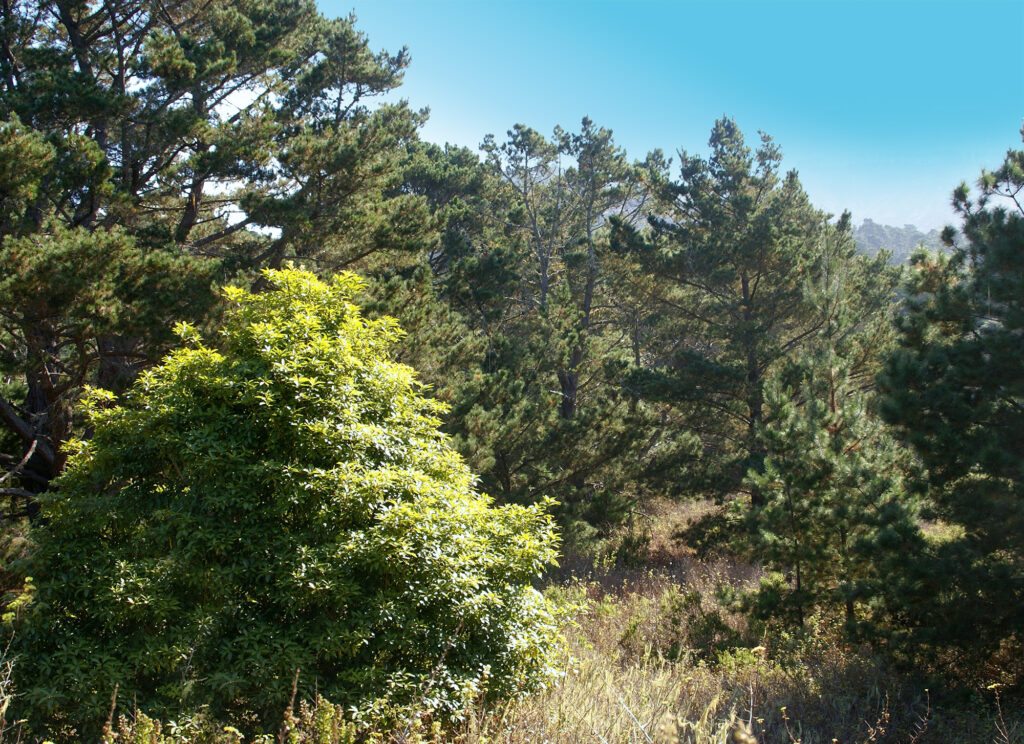
Male cones grow in clusters on the tips of branches. Female cones are much larger, unevenly conical with little or no stalk, pointing downward. These cones can persist unopened on the tree for several years, and each year’s growth is marked by a radial cluster of cones around the branch. Monterey pine is a closed-cone pine; cones do not open as soon as the seeds ripen, but open only in response to heat. Unlike Bishop and knobcone pines, Monterey pine cones will open on a hot day as well as in a forest fire, but fire suppression raises questions about the long-term viability of this iconic tree.
Coast Live Oak
To appreciate an old coast live oak (Quercus agrifolia var. a.), one must stand beneath its shady dark hemispheric canopy which is supported by a twisted gray superstructure of gnarled branches. Multiple trunks are common, and the wide-spreading limbs sometimes trail along the ground. Its tough hard leaves are oval and convex, from one to three inches long; the margins are spiny and there are small hairs on the undersides. “Live” in its name means evergreen as opposed to deciduous; though it drops leaves throughout the year, it maintains its dense dark green crown. They commonly live more than 250 years.
Smooth gray bark becomes brownish and furrowed with age. Acorns are conical, ¾ to 1½ inches long, a rich reddish-brown in color. They were a staple food for many Native American tribes, and Spanish settlers associated the tree with fertile lands. While the wood grain was somewhat irregular to be used by pioneers in construction, it made fine charcoal for early industries. Mission builders used it to fire their lime kilns to make adobe mortar, and in fact the locations of the Franciscan missions closely match the coast live oak’s native range, from northern Baja California to Mendocino County.
Coast live oaks thrive on the well-drained soils of coastal plains, though not on the immediate shore. They are the most characteristic tree within a fifty-mile-wide swath from the ocean across the Inner Coast Ranges, where climate is mild and fog is common. Robert Louis Stevenson described the dense coast live oak forests around Monterey as “woods for murderers to crawl among.” Be that as it may, they are as much a part of western California as are its golden hills.
Monterey Cypress
Visitors to Point Lobos are familiar with the Monterey cypress (formerly Hesperocyparis macrocarpa), perhaps the terrestrial symbol of the reserve. We see the cypress all around the Monterey peninsula and forget how unique it is. There are only two native stands: one at Allan Memorial Grove in Point Lobos and the other at Crocker Grove in Pebble Beach. California lists it as a Category 1 rare and endangered species, but since it is widely planted as a landscape tree, it is not on the federal list of endangered species – the federal list does not distinguish between natural populations and planted specimens.
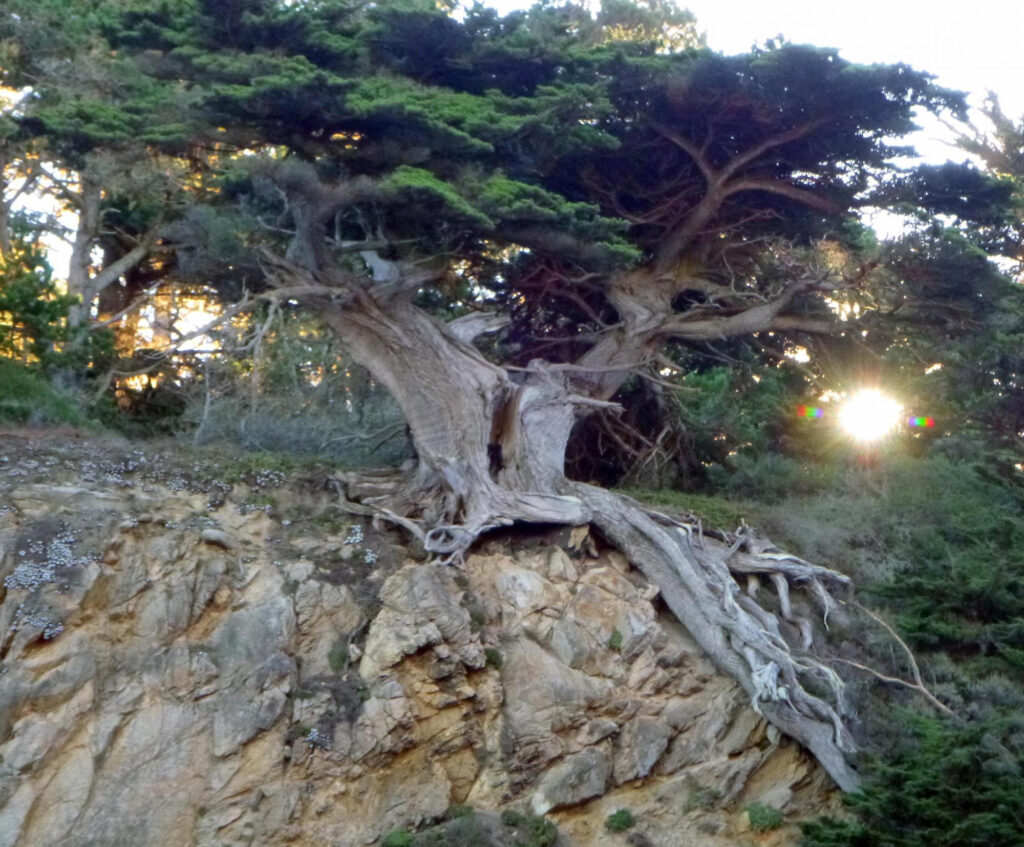
Cypresses in the Allan Memorial Grove at Point Lobos are especially valuable because of their isolation from planted cypresses originating from other areas. As close as Pebble Beach is to Point Lobos, there are genetic differences between the two populations and minor variations in cone structure. Because they are surrounded by a residential area, cypresses in the Del Monte Forest (Pebble Beach) are also more likely to hybridize with cypresses planted as landscape trees. Monterey cypresses typically live 200 or more years; individual trees could possibly live as long as 400 years.
Schrubs

Shrubs are most easily seen in where there are no trees, primarily in the coastal scrub zones and in the transition zones between the coast and the forests. Here these low-growing plants get plenty of sun and less competition for nutrients from tree roots. Some of the shrubs described below also exist in the pine forest. They are adapted for living without rain for months at a time, and also offer a bit of color and pleasant aromatic scents. But beware of the profusion of poison oak, which can ruin your trip if you venture into it. For that reason, it is described first.
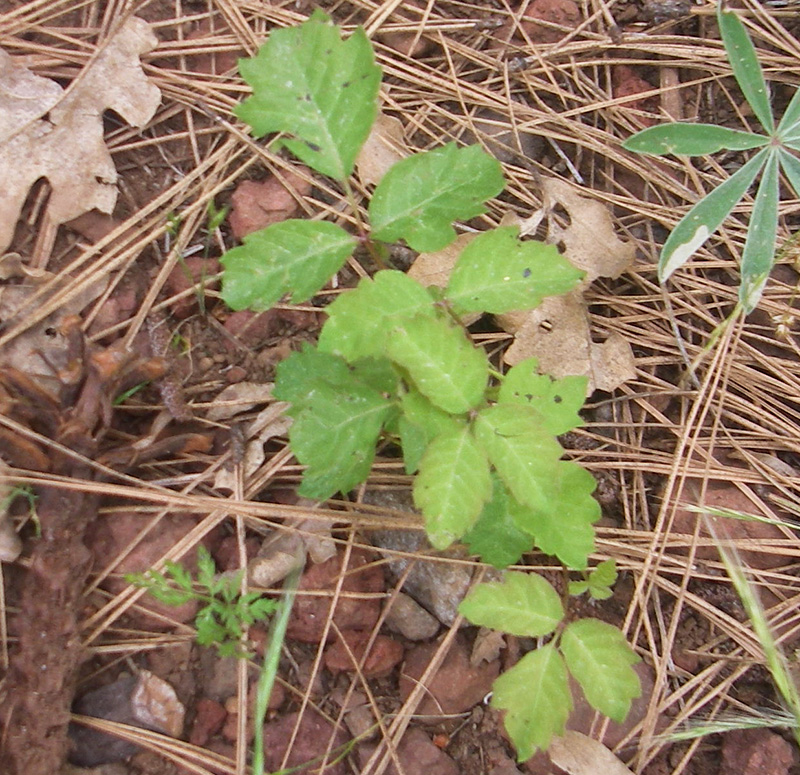
Poison oak (Toxicodendron diversilobum)
This plant thrives and is an integral and important native plant in the Reserve and surrounding lands. Many animals use it for both food and protection from predators. It is a handsome addition to our flora with shiny green leaves which, in the fall, give us our best red-color scenery. The “leaves of three” are usually about 1 and 1/2 to 4 inches long with lobed, toothed, or scalloped edges and do resemble the lobed leaves of true oaks. Later in the season, all the leaves may be lost – deciduous – making identification far more challenging. Poison oak can be a 1 foot to over 10 feet tall, be a creeper on the ground, or a climbing vine going far up supporting trees, sometimes 30 feet or more. It can also form large masses of dense shrubs.
You need to be able to recognize this plant if you are visiting California wilderness areas, as touching it can cause an incredibly itchy, blistering, weeping, red bumpy rash that could turn into a secondary bacterial infection. The oil which causes an allergic contact-dermatitis reaction in the great majority of us can be transferred to your skin from both the leaves and the leafless branches. If you have children with you who love to touch everything, be sure to teach them about it or caution them to touch nothing!
Interestingly, Native Americans were not nearly as allergic and used poison oak in many ways, including basket weaving, making dyes, and medicinally for multiple disorders. California blackberry, another prominent inhabitant in the reserve with “leaves of three,” does not cause a rash; its thorns (or “hair” in ditty below) make it possible to distinguish it from poison oak.
Leaves of three, let it be!
If it’s shiny, watch your heinie!
If it’s hairy, it’s a berry!
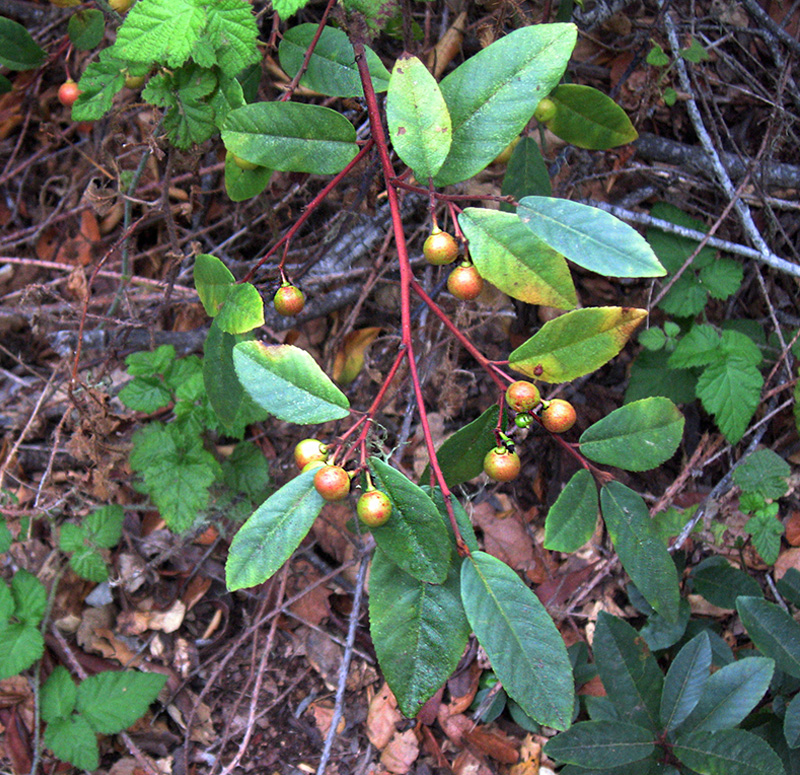
California coffeeberry Frangula (formerly Rhamnus) californica
Coffeeberry can be a small one foot high shrub or can grow to a towering 10 feet and lives up to 200 years. It is not a strikingly beautiful flowering plant; nonetheless, it is a handsome evergreen, very often found in native plant gardens. Coffeeberry is found throughout California mostly in woodlands, chaparral and the Northern Coastal Scrub.
Birds, deer and livestock feast upon the fruit of this native. Even if they do look like actual coffee berries, they contain no caffeine; and the two plants are not related. Coffeeberry was a source of medicine and food for Native Americans in the past. However, ingesting parts of the plant can be a dangerously effective laxative for an uninformed person.
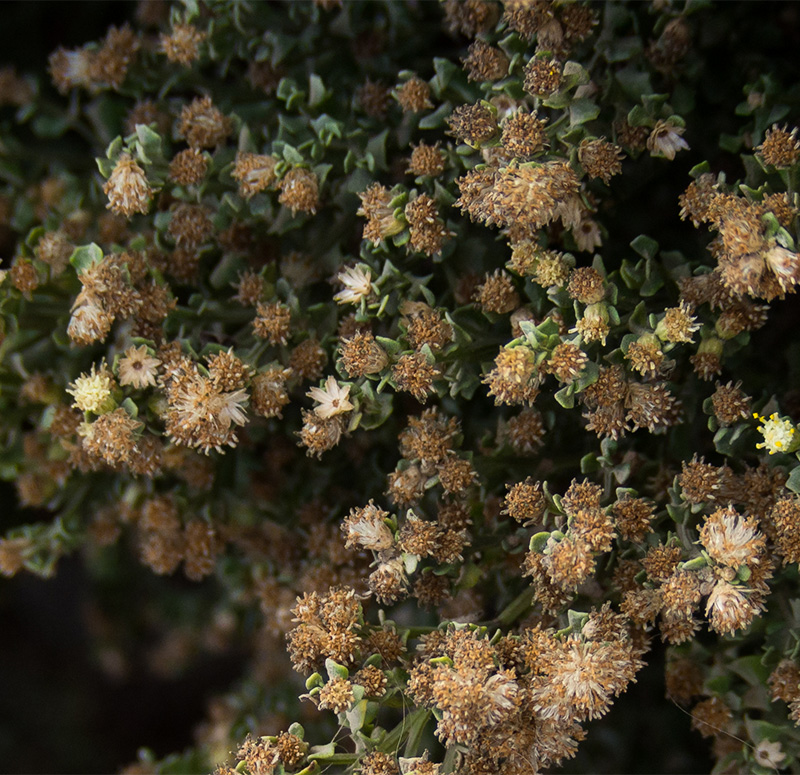
Coyote Brush Baccharis pilularis ssp. consanguinea
This erect or rounded shrub is an evergreen plant with rery small leaves and leggy brittle branches, which grows up to 15 feet tall. It hates shade, and its seeds struggle to grow without sunlight. Coyote brush tolerates drought exceedingly well because the leaves have a waxy coating that reduces evaporation. Its range is widespread through California in a variety of habitats from coastal bluffs to oak woodlands, grasslands, hillsides and canyons. Coyote Brush also contains a chemical that makes it moderately fire tolerant. Even if the plant is burned, the extensive root system usually survives to sprout again.
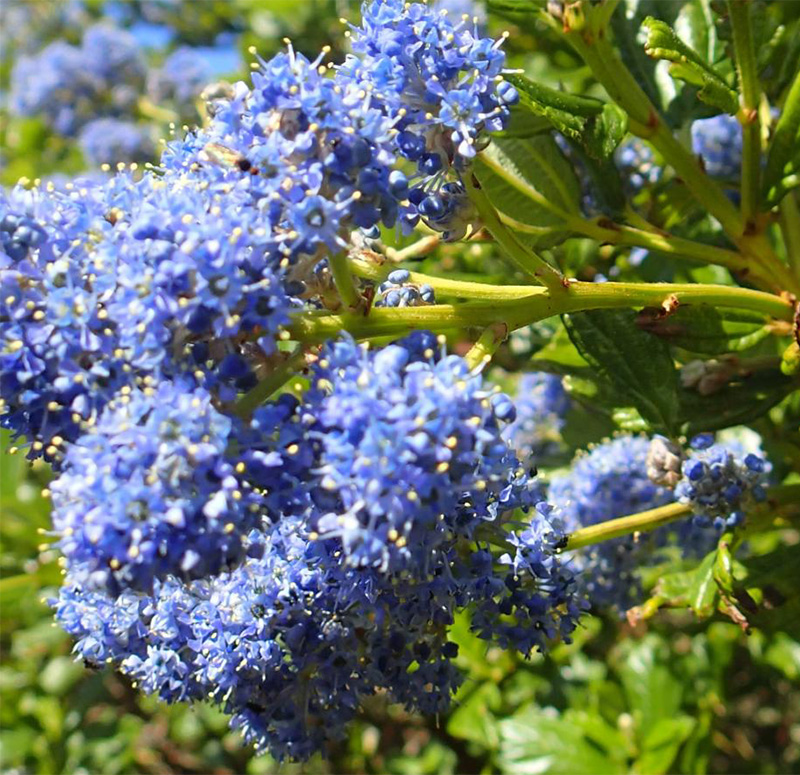
Blue Blossom (California lilac) Ceanothus thyrsiflorus
This is a most magnificent evergreen. It can be a widely branching shrub standing two feet tall or a small tree stretching out to over twenty feet. Three prominent nearly parallel veins mark its dark green elliptical to oval leaves which complement the stunning perfumed blossoms. Eye-catching dense clusters of tiny flowers varying in color from very light to dark blue grace this plant. Widely used as an ornamental landscape plant, it has been given special recognition by the Royal Horticultural Society of England.
It is especially important for both native bees and butterflies. Many birds enjoy its seeds; hummingbirds “savor” its nectar. This plant is native to California and southern Oregon. It is drought tolerant, preferring well-drained soils near the coast. While Native Americans utilized the plant as a dye and food, their use of its fresh or dried flowers as a gentle soap is more widely known.
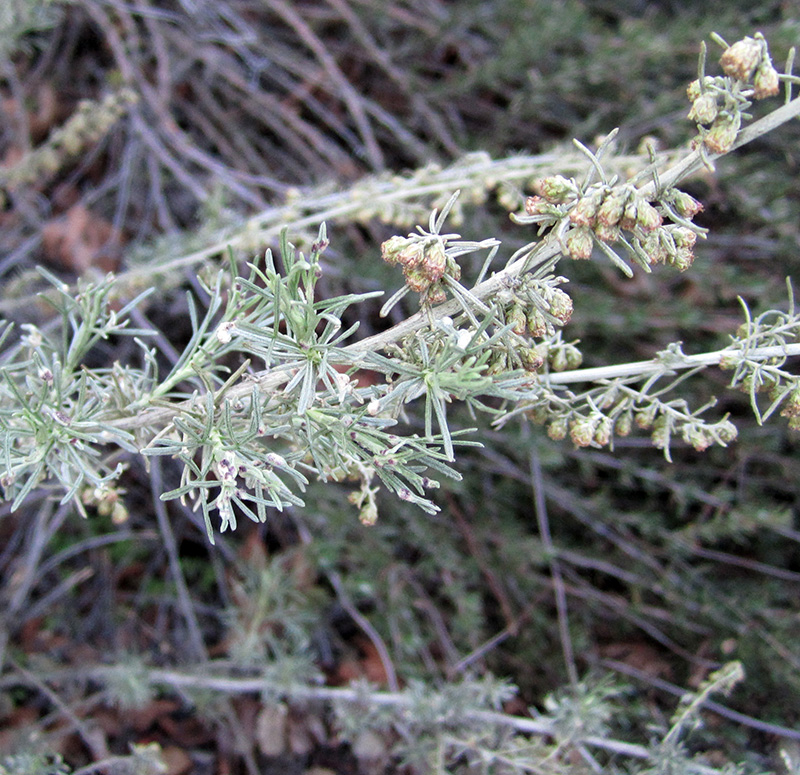
California Sagebrush Artemisia californica
This plant is found in great abundance in the coastal scrub. Growing 2 to 5 feet tall, it has woody lower branches and is drought resistant. Though highly flammable, it often grows back after fires. While not a true sage, i.e., not a Salvia, the thread-like leaves do have a delicious sage-like odor thanks to its terpene oils. However, this shrub makes a horrible “neighbor” as its oils also interfere with the growth and reproduction of plants around it.
Sagebrush is perhaps the most important component of the coastal scrub. Birds, insects, reptiles, amphibians and mammals find it is a vital resource for nesting materials and food. It also provides them shelter from predators. Native Americans widely used sagebrush medicinally for both menstrual and respiratory disorders. They also used it dried as a burning smudge during purification rituals, as many people still do today.
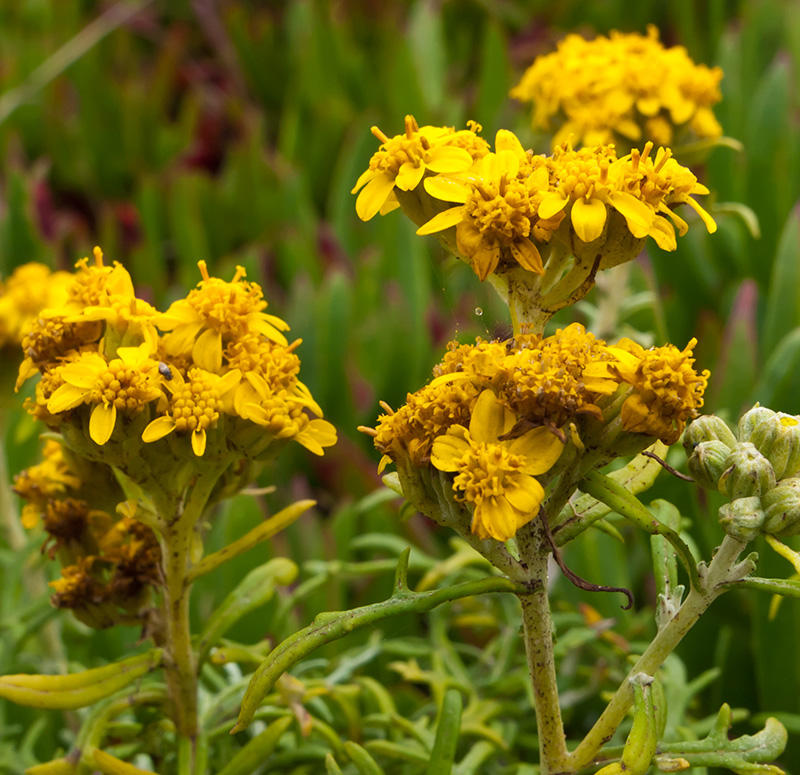
Lizard-tail (Seaside Woolly Sunflower) Eriophyllum staechadifolium
In the Asteraceae (sunflower) family, Lizard-tail is festooned with copious small, bright, yellow flowers in umbrella-like clusters from April to September. These delightful blossoms form a floral bouquet that provides bountiful nectar for butterflies, native insects and later seeds for birds. Some Native Americans used the dried and ground seeds to make pinole, a ground meal. They also placed lizard-tail leaves on their bodies to relieve sore areas.
Lizard-tail is a handsome drought-tolerant small shrub. Because it is also wind and salt-spray tolerant, this is an important sun-loving member of the coastal scrub lands. It is usually 2 to 3 feet in height, and most often has a mounding form about 2 to 3 feet wide. The green foliage of its many branches is garnished with fine wooly hairs under the leaves giving them a silvery contrast. The common name “lizard-tail” likely refers to the end of the often many-lobed and round-edged leaves, which bear a striking resemblance to the body of a lizard. Its close cousin Eriophyllum confertiflorum, frequently called Golden Yarrow, has smaller leaves; it is also found in the reserve but is much more common inland.
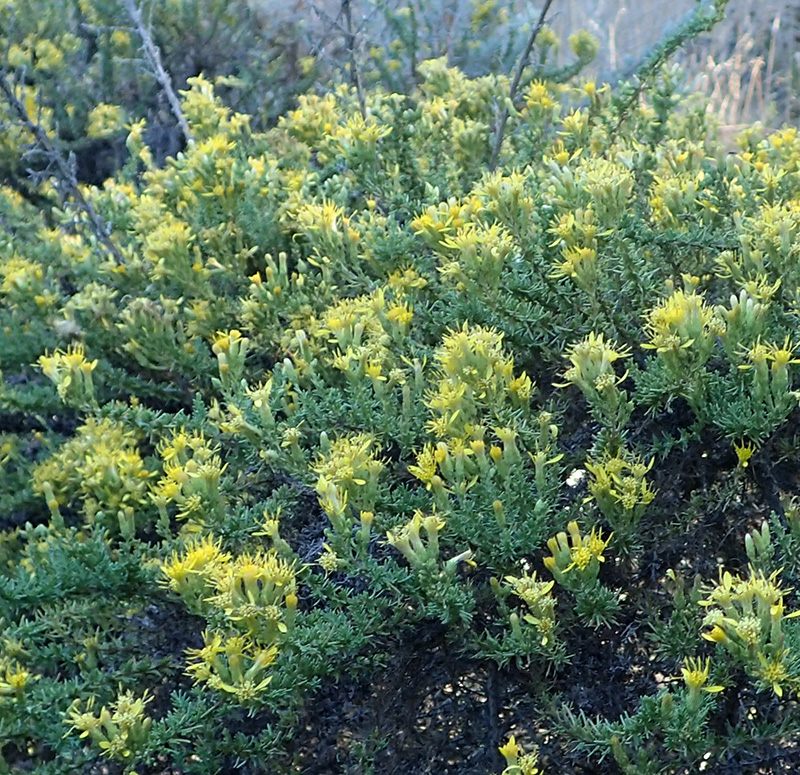
Mock Heather (California goldenbush) Ericameria ericoides
This plant is a member of the sunflower (aster) family, is identified by its compact, densely-leaved evergreen bush with many branches. Endemic to California (i.e., found naturally only in California), its range stretches from Sonoma County to Los Angeles County. It is commonly found in coastal scrub communities where it is a dominant denizen, tolerant of acidic, sandy and nutrient-poor soils. The plants are one to three feet tall with tiny, dense, resinous almost tube-like leaves in a fan shape. In late summer and fall, Mock Heather’s multiple small bright flowers can paint hillsides yellow.
Butterflies, bees and other pollinators feed upon its yellow blooms. Some Native Americans used Mock Heather leaves to heal skin sores.
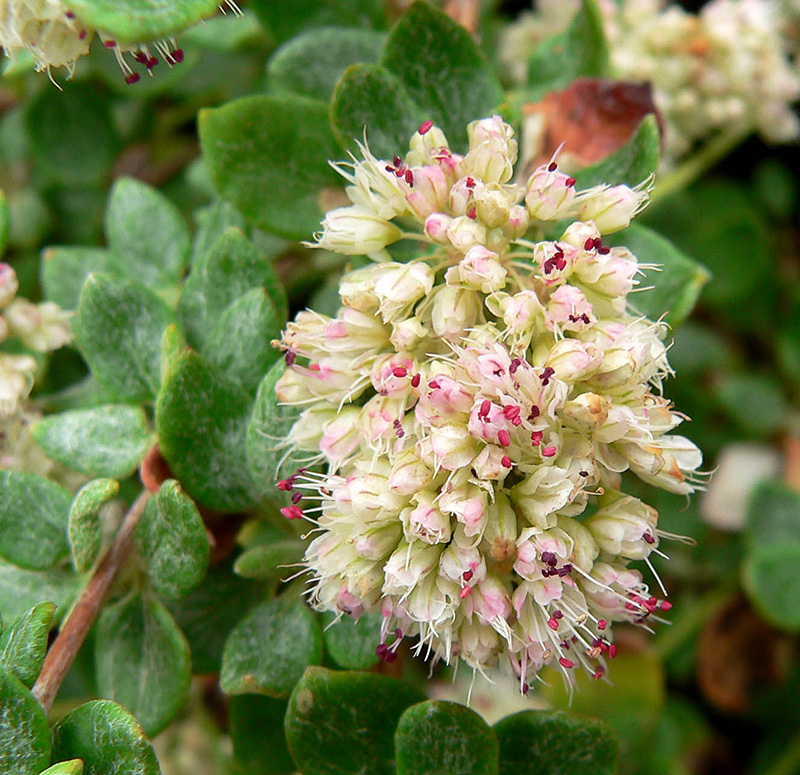
Dune Buckwheat Eriogonum parvifolium
Compact mounds of Dune Buckwheat grace our seaside bluffs. This low-spreading evergreen is 1 to 3 feet high and usually only a few feet wide. Its leaves are small, thick, and dark green with a reddish tinge on top, while wooly white underneath. This hardy shrub is tolerant of drought, sand, salt spray and soils which are slightly acidic to alkaline. Monterey is at the northern natural limit of this species which belongs to a very large and widespread family in California, the Polygonaceae or Buckwheat family. Its small ball-shaped blossoms rise above the foliage on slender stalks in copious numbers. These “balls” come in a range of colors – delightful white to pink as well as tan and light green – all of which turn to rusty red with age. These “puny pom-poms” are distinctive and catch our attention long after the primary summer flowering has finished.
Algae, Fungi and Lichen
These plant-like life forms are not true plants, but related closely to them.
Algae are found in many forms, from the huge, fast-growing microalgae like giant kelp and bull kelp in the ocean to microscopic algae floating free in the water. Both photosynthesize to produce oxygen and sugars. Giant kelp grow from a “holdfast” that has attached itself to rocks on the bottom and are pulled to the surface by gas bladders that provide buoyancy. One form of algae elicits many questions from visitors who mistakenly identify it as a fungus and assume (possibly due to its rusty-red color) that it is killing the trees on the Cypress Grove trail. Not so. It is really algae that migrated to Point Lobos as tiny spores, named Trentepohlia. It grows very few places on earth and only on the northern edge of Point Lobos. Since it only thrives in pristine air, be sure to fill your lungs when you are there. Ask any docent where to find it.
The most commonly identified fungi are mushrooms. A wide variety of mushrooms appear after our winter rains have started.
Lichen (pronounced “liken”) is a symbiotic life form composed of both algae and fungi. The fungus forms the structure to provide a “home” for the algae, and the algae’s photosynthesis produces sugars that feed both. There are roughly 15,000 different lichens on earth. At Point Lobos, they are most evident in trees and on rocks, and the most obvious lichen is lace lichen, hanging on trees like as “old man’s beard”, a common name for it. People who have been to the US Southeast frequently confuse lace lichen with Spanish moss, which is parasitic while lace lichen is not. Some birds use it to make a soft nest for their eggs, and Native Americans used it to cushion their babies. Since it is very absorbtive, it was also used in diapers – when soiled it was completely biodegradable. You can find it throughout the reserve on pines, cypresses and oaks.
Plant Communities

Plant communities are typically named for their dominant species (e.g. Monterey Pine Forest), general character (e.g. Coastal Prairie), or habitat (e.g. Coastal Bluff.) Each community exists where it does as a result of interactions among climate, soils, topography, plants, animals, fire, man, and time.
Boundaries of plant communities, called ecotones, can be gradual or abrupt. They are biologically the most productive areas in that animals may find shelter in one area and more abundant food in the other.
Listed below are the plant communities of Point Lobos, the trails which traverse them, and their characteristic plants.
Monterey Cypress Forest
Trails: Cypress Grove
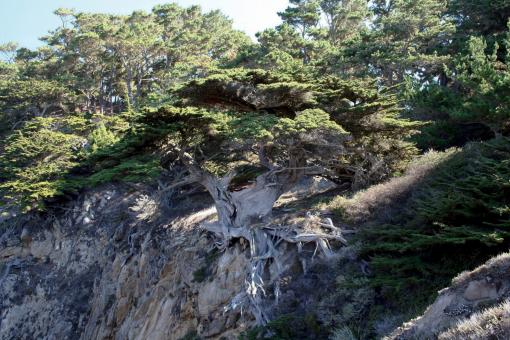 Harsh growing conditions on Cypress Point and the deep shade beneath the cypresses, plus the shallow nutrient-poor soil, limit the number of shrub and understory species growing in the cypress forest. Once more widespread, Monterey Cypress Forest is now limited to two places at the north and south ends of Carmel Bay: Crocker Grove in Pebble Beach and Allan Memorial Grove at Point Lobos.
Harsh growing conditions on Cypress Point and the deep shade beneath the cypresses, plus the shallow nutrient-poor soil, limit the number of shrub and understory species growing in the cypress forest. Once more widespread, Monterey Cypress Forest is now limited to two places at the north and south ends of Carmel Bay: Crocker Grove in Pebble Beach and Allan Memorial Grove at Point Lobos.
Lace lichen is often found growing on the cypresses; it is not parasitic and does not harm the trees. The trees closest to the direct salt spray are often covered with a bright orange growth: Trentepohlia, a green alga rich in beta carotene, which gives it its orange color. It too is non-parasitic and is also found growing on rocks and downed wood along the trail. Both the alga and the lichen condense moisture from the fog; it drips down into the root zone of the trees and provides extra water during the dry season.
Monterey Pine Forest
Trails: Whalers Knoll, North Shore, Lace Lichen, Pine Ridge
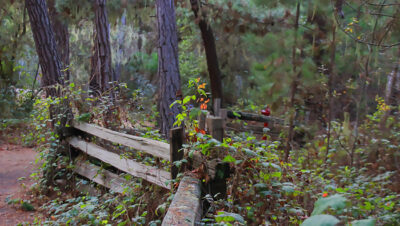
Point Lobos State Natural Reserve forest path. Photo credit: Janet Beaty.
Monterey Pine Forest is an example of the classic plant community structure: tree species which dominate by their sheer size, the quantity of nutrients absorbed by their roots, and needle/leaf litter dropped; a shrub layer (e.g. Ceanothus, coffee berry, poison oak); and understory of low-growing plants (e.g. wood mint, Douglas iris.) The size of the Monterey pine and the density of the canopy limit the plants growing in association with the pines to those able to tolerate deep shade. Also, the soils are quite shallow and nutrient-poor.
Fire is an integral part of a healthy Monterey pine forest. Without periodic burns, whether started by lightning, Native Americans in the past or rangers today, the pine forest becomes a thicket of spindly trees crowding out other species. Too many nutrients are locked up in dead vegetative matter on the forest floor to support healthy plant growth. However, where a pine forest exists in proximity to human habitation, prescribed burns can be difficult to sell to the public.
Also found in this community is the coast live oak – “live” because it is an evergreen, not deciduous, tree. In the open it can reach 50 – 70 feet; within the pine forest it remains smaller. Coast live oaks live longer than pines, so without periodic fires to regenerate the pines, oaks might in time replace pines as the dominant species.
Frequently growing on both oaks and pines is lace lichen, Ramalina menziesii. It grows on tree branches, taking advantage of openings in the canopy to grow in the light. It is not parasitic on the trees.
Northern Coastal Scrub
Trails: Sea Lion Point, Sand Hill, South Shore, Bird Island, North Shore, Cypress Grove
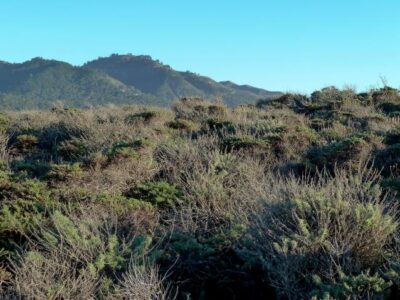 This shrubby plant community is found just along the coast, in a narrow strip from southern Oregon to San Mateo County, and in Monterey County from Pacific Grove to Point Sur. It features shrub species growing tightly together with a weakly developed understory. The dense plant growth helps the whole community to conserve moisture to survive the dry summer and also provides cover for many small animals.
This shrubby plant community is found just along the coast, in a narrow strip from southern Oregon to San Mateo County, and in Monterey County from Pacific Grove to Point Sur. It features shrub species growing tightly together with a weakly developed understory. The dense plant growth helps the whole community to conserve moisture to survive the dry summer and also provides cover for many small animals.
Plants display various adaptations to their harsh conditions, to minimize moisture loss and reduce exposure to sun:
- Deciduous in dry weather – coast sagebrush, poison oak, bracken fern
- Gray foliage to reflect sunlight – coast sagebrush, California everlasting
- Waxy or oily coating on leaves – coyote brush, Ceanothus, poison oak
- Fine hairs on leaves, reflecting sunlight – lizard tail, California everlasting
- Relatively small leaf area – most species
Coastal Bluff
Trails: Sea Lion Point, Sand Hill, Bird Island, Granite Point
Coastal Bluff is found atop and on the upper parts of the cliffs directly facing the ocean, above reach of the waves. This is a sub-community of Northern Coastal Scrub, and many of the plant species are the same, although individuals may be much smaller. Plants must adapt to extreme conditions: intense sun or dense fog, very shallow soils or bare rock, direct salt spray, and wind.
Northern Coastal Prairie
Trails: South Shore, Granite Point, Moss Cove
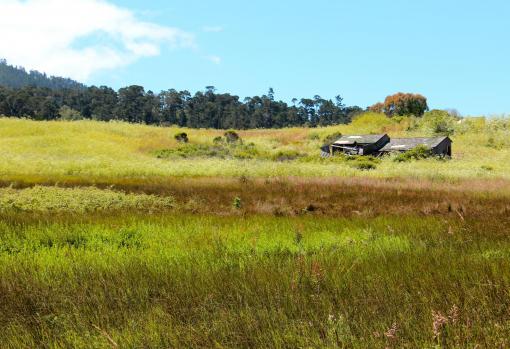 Meadows within the reserve (Hudson Meadow, Mound Meadow) are the southernmost examples of Northern Coastal Prairie, where plants consist only of grasses and very low-growing herbaceous plants.
Meadows within the reserve (Hudson Meadow, Mound Meadow) are the southernmost examples of Northern Coastal Prairie, where plants consist only of grasses and very low-growing herbaceous plants.
Native Americans set fires to thin invading shrubs to improve forage for deer, making hunting easier. They also used seeds of the giant rye grass, found in Mound Meadow, for food. This grass is well adapted to fire and produces much seed following a fire.
Recent prescribed burns are attempts to restore meadows to their condition before the arrival of Spanish settlers. Native grasses, called “bunch grasses,” are perennials growing in deep-rooted clumps which survive fire and re-sprout vigorously; most introduced grasses are shallow-rooted annuals easily destroyed by fire.
Extensive grazing has greatly degraded the native grasslands; many native grass species have been crowded out by introduced species. These forces along with fire suppression have made coastal prairies extremely rare, and the great diversity of plant life represented makes their preservation even more important.
Geology

The story of Point Lobos begins with its rocks. The existence of the point and its remarkable character derives largely from geologic processes.
A dramatic history is recorded here. It includes the crystallization of molten rock deep within the crust of the earth and the grinding interactions of great plates of the earth’s crust. One sees at Point Lobos the deposits produced by torrents of sand and gravel that swept through the quiet depths of an ancient submarine canyon, and the elaborate tunnels and burrows of unknown creatures that lived on and beneath the canyon’s floor.
The rocks that underlie Point Lobos originated many miles to the south, in Southern California or even northern Mexico. They are part of a slab of the North American Plate that was broken off by the grazing collision of the continental plate and the oceanic Pacific Plate. The slab adhered to the Pacific Plate and was carried north with that plate. Even today, the rocks of Point Lobos continue to creep toward the northwest with the Pacific plate.
The geologic story continues through the recent ice ages when sea level rose and fell and the movement of the crust raised the coastal rocks and created our existing mountain ranges. It continues today as the processes of weathering and erosion sculpt the rocks along the coast.
Rocks and Fossils
A useful brochure is available to help you spot interesting rocks when you visit the Reserve.
For a detailed description of the rocks that underlie the Reserve, view “The Rocks of Point Lobos”.
“Trace Fossils of the Carmelo Formation” provides a description of the burrows and trails made by the animals that thrived beneath the floor of an ancient submarine canyon.
Check out “Concretions, nodules and weathering features of the Carmelo Formation” to learn more about the colorful and bizarre features in the sedimentary rock.
Geologic Time and Change
“Point Lobos and Geologic Time” illustrates how these rocks relate to geological time and the history of the earth.
To see how Point Lobos was geologically assembled, visit “The Geologic Evolution of Point Lobos”.

